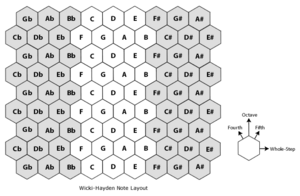Wicki-Hayden note layout facts for kids
The Wicki-Hayden note layout is a special way to arrange musical notes. It's different from a regular piano keyboard. This layout makes it easier for musicians to play. It helps them use the same finger movements for all 12 musical scales.
Contents
Understanding the Wicki-Hayden Layout
This unique layout helps musicians play more easily. On a regular piano, you learn different finger patterns for each musical key. But with the Wicki-Hayden system, you learn one pattern. This one pattern works for every key! Imagine learning to tie your shoes once, and that method works for all your shoes. That's how simple it makes playing music.
What are Musical Scales?
A musical scale is like a ladder of notes. It's a series of notes played in a specific order. For example, the "C major scale" starts on C and goes up through D, E, F, G, A, B, and back to C. There are 12 different major scales in music.
Why is Fingering Important?
"Fingering" means which fingers you use to press the notes. When you play an instrument, you learn specific finger patterns. These patterns help you play smoothly and quickly. The Wicki-Hayden layout makes these patterns the same for all scales. This saves musicians a lot of time and effort.
History of the Wicki-Hayden Layout
The idea for this clever note layout came from two different people. They both wanted to make music easier to play.
Kaspar Wicki's Original Idea
The first person was Kaspar Wicki. He was from Switzerland. In 1896, he got a patent for his new note layout. A patent means he officially registered his idea. This protected his invention.
Brian Hayden's Improvements
Later, a concertina player named Brian Hayden improved Wicki's design. A Concertina is a small, portable musical instrument. It's like a small accordion. Brian Hayden made the layout even better. He then patented his improved version in 1986. This happened in Great Britain. His work made the Wicki-Hayden layout popular for concertinas.
Images for kids








